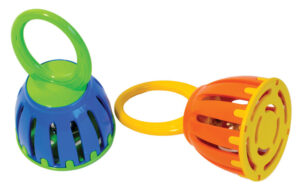Self-control
Toddlers watch how a caregiver calms down after engaging in an exciting activity.



[Invite several toddlers to join to learn a new song with a bell.]
 I have a bell. This is what it sounds like when I ring it!
I have a bell. This is what it sounds like when I ring it!
[Shake the bell to make it ring.]
I am going to ring my bell while I sing a new song!
[Demonstrate each way you will ring the bell during the song.]
I am going to ring it up and then down— like this. I am going to ring it loud—like this!
[Speak quietly.]
I am going to ring it quietly. Listen to the quiet sound of the bell!
Are you ready to hear the song?
[Enthusiastically sing the following song. Shake the bell in ways described in the song. Smile and make eye contact with each toddler as you sing. (Tune: Row, Row, Row Your Boat.)]
Ring, ring, ring your bell,
Ring it up and down.
Ring it loud, ring it soft,
Ring it to the ground.
Would you like me to ring my bell to the song again?
[If the toddlers respond positively, repeat the song rhyme enthusiastically with actions.]
I had fun ringing my bell to this song! I got excited when I rang the bell and sang the song! I put my bell to the floor when it is time to be calm.
The song is over. I am going to take a break to calm down. I am going to place my bell on the floor and take a deep breath. I am going to breathe slowly and close my eyes.
[Close eyes briefly and take a slow deep breath.]
I had fun ringing my bell to this song! I rang it up and down, then loud and quiet! I put my bell on the floor when it was time to calm down. I rested my body at the end of the fun song. Now I feel calm.
Self-control
Toddlers practice calming down with caregiver guidance after engaging in an exciting activity.



 Invite several toddlers to join you on the floor with the bell shakers. Give each toddler a bell and invite toddlers to explore the sound they make. You may wish to demonstrate ringing the bell up and down, and making louder and quieter sounds. After the toddlers have explored the bells, invite them to watch and listen to a song about ringing a bell. Then enthusiastically sing the song with actions offered in Option 1. Invite the toddlers to move their bells and join you in singing the song. Again, enthusiastically sing the song while demonstrating the corresponding actions with the bell. Encourage toddlers to join you.
Invite several toddlers to join you on the floor with the bell shakers. Give each toddler a bell and invite toddlers to explore the sound they make. You may wish to demonstrate ringing the bell up and down, and making louder and quieter sounds. After the toddlers have explored the bells, invite them to watch and listen to a song about ringing a bell. Then enthusiastically sing the song with actions offered in Option 1. Invite the toddlers to move their bells and join you in singing the song. Again, enthusiastically sing the song while demonstrating the corresponding actions with the bell. Encourage toddlers to join you.
After one or two rounds of toddlers joining you in moving their bells with the song, explain that our song and bells have made us feel excited and it is time for all of us to calm down. Lead toddlers in calming down. Explain and demonstrate: “We put our bells on the floor when it is time to calm down. We sit quietly and take a deep breath. We can close our eyes, too. Our bodies get calm.”
Acknowledge toddlers’ efforts to calm down with you after the exciting activity. Example: “We got excited ringing our bells. Now we are calming down. We are sitting quietly and resting our bodies.”
Self-control
Toddlers independently practice calming down after engaging in an exciting activity.



 Invite several toddlers to join you on the floor with the bell shakers. Invite each toddler to select a bell and explore the sound it makes. Introduce the song and show the toddlers how to ring their bells to the words of the song. Enthusiastically sing the song and demonstrate the corresponding actions, encouraging toddlers to join you. Emphasize the actions of up, down, loud, and quiet. Describe and demonstrate how to calm down, using the procedures described in Option 2.
Invite several toddlers to join you on the floor with the bell shakers. Invite each toddler to select a bell and explore the sound it makes. Introduce the song and show the toddlers how to ring their bells to the words of the song. Enthusiastically sing the song and demonstrate the corresponding actions, encouraging toddlers to join you. Emphasize the actions of up, down, loud, and quiet. Describe and demonstrate how to calm down, using the procedures described in Option 2.
Then invite the toddlers to do the actions independently as you sing the words. Some toddlers may want to join you in singing as well as ringing their bells. Repeat the song several times without the calming down segment if toddlers remain interested and engaged. Acknowledge each toddler’s participation and enthusiasm during the song. Example: “You rang your bell up high, Amelia! Then you rang it down low. You liked ringing your bell. You are laughing and having fun!”
After one or several rounds of song and actions with the bells, announce that it is time to calm down. Remind toddlers that we put our bells on the floor and then calm our bodies. Offer verbal guidance on taking a deep breath and maybe closing our eyes for a little bit. Remind toddlers that we are quiet when we rest our bodies.
Recognize and acknowledge each toddler’s efforts to calm down after the exciting activity. Example: “You had fun ringing your bell, Aaron! At the end of the song, you put your bell on the floor and sat quietly. You are practicing how to calm your body.”
The calming down segment is an important part of this activity plan. Look carefully at the ease with which toddlers notice and practice how to calm down. You may wish to repeat this part of the activity by again demonstrating and/or leading toddlers in calming down. Some toddlers will find it challenging to calm down, including not touching or moving their bell. As suggested in an Extra Support tip, it may be helpful for toddlers to place their bells in a basket that is out of their reach while practicing how to calm down. One-to-one use of Option 2 may be appropriate to pursue with toddlers who find the calming down segment to be especially challenging. It is important for each toddler to experience success with at least part of the activity.
The primary purpose of the song and actions is to provide some excitement prior to practicing how to calm down. Precise or uniform actions are not the activity goal. At the same time, pay attention to signs of toddler awareness of the concepts of up, down, loud, and quiet. Each of these is named and demonstrated in the song. You may wish to emphasize or repeat a demonstration of a concept that seems unfamiliar to toddlers.
Toddlers are not expected to learn and sing the song in its entirety, although encouraging toddlers to say or sing “ring” may add to their enjoyment of the activity.
Option 3 is the most challenging, by design. The Option 3 plan suggests you sing the song but encourage toddlers to move their bell independently. You may wish to modify this suggestion by moving your bell while singing the song. Independent practice in calming down can be encouraged by providing verbal guidance, as suggested in the plan.
Extra support
Enrichment
Materials Needed: Baby Bell Set (caged bells, age 3 months +), assorted age-appropriate musical instruments, basket, music player with soft music
Place the bells and other instruments in a basket. Invite several toddlers to play a game of ‘play’ and then ‘stop.’ Play soft music and encourage toddlers to play their instruments and bells. Stop the music and encourage toddlers to put down their instruments. Repeat this game several times, encouraging toddlers to quiet their instruments each time the music stops. After the game, invite the toddlers to sit quietly with you and practice calming down (see activity plan) before moving on to another activity.
Materials Needed: variety of age-appropriate musical instruments (including baby bells), basket
Children of all ages enjoy making music with toy instruments. Place the instruments in a basket and invite each child to select and “play” an instrument. (If conflicts arise over particular instruments, you may wish to pass the instruments out and encourage the children to exchange instruments every several minutes.) Sing a variety of songs with children, such as the bell song in the activity plan (see Option 1). Encourage children to play their instruments with corresponding actions such as ‘up’ and then ‘down.’ Babies will enjoy holding their own baby bell to shake and ring. Before moving to the next activity, invite all the children to place their instruments in the basket and sit quietly for a few moments.